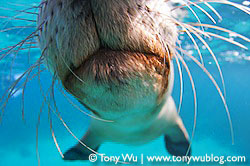 I've been struggling for some time now to write something about my recent trip to swim with sea lions. Struggling not so much because of writer's block, but more due to writer's flood, if there is such a thing.
I've been struggling for some time now to write something about my recent trip to swim with sea lions. Struggling not so much because of writer's block, but more due to writer's flood, if there is such a thing.
You see, swimming among sea lions at Carnac Island is at once exactly like all other marine encounters I've had (in the sense that I see and learn a lot, have as much fun as possible, and try to return with the best photos possible), yet it's entirely different too.
Much of my in-water interaction with sea lions took place at a pace and level of frenzy akin to the pandemonium of Carnival in Rio. When sea lions decide to play, they really play. They charge, swoop, twist, turn, flip, roll, glide, duck, twirl...perform just about every acrobatic manoeuvre in the dictionary, and then some. The result, of course, was complete sensory overload, with my brain working overtime to keep up with and process everything taking place.
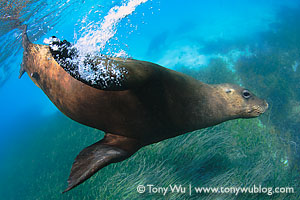 So even now, I'm struggling to "catch up" with the things I experienced.
So even now, I'm struggling to "catch up" with the things I experienced.
The best way I can think of to describe the feeling is like watching an old kung fu flick, where the soundtrack lags behind the video, so you get that out-of-sync sensation, and your brain has to process the time delays to work out which guy is going to whoop which other dude with what top-secret kung fu style based on which exotic animal. Make sense?
Anyway, the bottom line is that each time I've sat down to write, more stuff came flooding into my head, making it imposssible for me to figure out what to write...hence, writer's flood.
One thing that puzzled me for a while was that I don't recall experiencing this phenomenon after my inaugural sea lion adventure last year. Upon reflection, I think it may have been because I wasn't observing as closely a year ago as I was this year.
 What I mean is that whenever you experience something for the first time, everything is new (duh).
What I mean is that whenever you experience something for the first time, everything is new (duh).
To clarify, in an unfamiliar situation first impressions dominate, so you're taking in the most basic level of information. The first time you scuba dive, for instance, you'll probably notice the pretty sea fans, but you might not pick up on the little commensal squat lobsters hiding among crinoids perched on those fans; whereas once you're a seasoned diver, you can't imagine missing such cute little critters.
In the context of sea lions, what this meant in practicality for me was that I focused (excuse the pun) a lot this trip upon observing behaviour. Not that I didn't before, but I wasn't necessarily as bamboozled by the overwhelming cuteness of the sea lions as I was last year, so I could concentrate more on watching what the playful pinnipeds were doing. In others words, I was able to see beyond the pretty faces and look for more substance.
Points to Ponder
Given the summary I wrote about Australian sea lions last year, I'm not going to write too much more about them now. There is, in fact, not that much more that I can write, given the dearth of information about them.
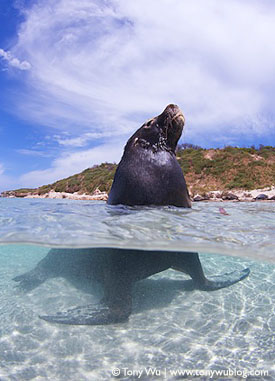 I do however think it's worth noting a few anecdotal observations here, in case anyone who's conducting research on these wonderful marine mammals reads this.
I do however think it's worth noting a few anecdotal observations here, in case anyone who's conducting research on these wonderful marine mammals reads this.
First, it was extraordinarily hot for the week that I was in Western Australia. The temperature was at least 35ºC, and shot up to 37ºC on some days. It was apparently the hottest that it had been in that part of Down Under Land for the past 40 years.
The water temperature was somewhat warmer than I recalled too, so much so that I was able to get into the water on sunny days with no wetsuit. Anyone who's travelled with me knows I hate being cold, so this is saying something. I was still cold, but the strong sun, hot conditions and somewhat warmer water made it (only just) bearable.
The reason I risked hypothermia of course, was that it's much easier to swim, do flips in the water and generally keep up with the sea lions without the added drag of a wetsuit. With the amount of swimming I was doing each day, this made a significant difference to how tired I was at the end of each day (i.e., being utterly pooped instead of drop-dead exhausted).
Back to the point...with the exceptionally hot conditions, the sea lions seemed to leave the beach and go into the water more often than I recall from last year, when it was chilly on many days. In addition, they seemed to stay in the water longer (judging from our extended encounter times). Just a guess, but given the hot conditions, perhaps the sea lions felt the need to go in for a refreshing dip more often and for longer than if it had been cooler. Makes sense to me.
 Next, following a nearly all-day play session the first day we visited the island, each day thereafter, upon setting anchor, sea lions swam up to the boat to check us out, and a few times seemed to "hang around" waiting for us to get in. They did not seem to do so with other boats. It's worth noting that people in other boats mostly didn't swim with the sea lions, and those who tried weren't properly equipped and/ or weren't such great swimmers, so weren't able to hold the perky pinnipeds' interest for long.
Next, following a nearly all-day play session the first day we visited the island, each day thereafter, upon setting anchor, sea lions swam up to the boat to check us out, and a few times seemed to "hang around" waiting for us to get in. They did not seem to do so with other boats. It's worth noting that people in other boats mostly didn't swim with the sea lions, and those who tried weren't properly equipped and/ or weren't such great swimmers, so weren't able to hold the perky pinnipeds' interest for long.
I have no idea whether Australian sea lions are intelligent enough to recognise boats, but it sure seemed like they remembered us and had pegged the boat as a source of entertainment.
Third, on one occasion, bottlenose dolphins came in for a closer look. The sea lion I was frolicking with immediately zipped off to play with the dolphins...and the dolphins reciprocated. I swam among them for a bit, but clearly couldn't keep up with the streamlined, hyperactive marine mammals. They swung around several times, buzzing other swimmers in the water and obviously enjoying themselves.
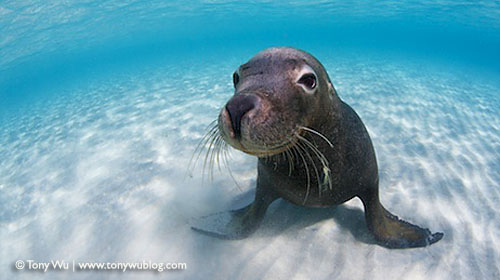 I've seen whales and dolphins playing together, but this is the first time I've witnessed sea lions and dolphins cavorting. I don't know whether this is common or not, but a quick Google search didn't turn up much. The scientific community cautions us not to ascribe human qualities to animals. In general, I agree, but hey, these animals were clearly playing and having a great time...together, which suggests they recognised one another as "fun" and elected to engage each other.
I've seen whales and dolphins playing together, but this is the first time I've witnessed sea lions and dolphins cavorting. I don't know whether this is common or not, but a quick Google search didn't turn up much. The scientific community cautions us not to ascribe human qualities to animals. In general, I agree, but hey, these animals were clearly playing and having a great time...together, which suggests they recognised one another as "fun" and elected to engage each other.
Oh Behave!
So having progressed beyond the warm, squishy feeling you can't help but get when faced with such adorable, cuddly animals, I devoted as much attention as possible to watching the sea lions, trying to pick up on behavioural patterns, body language and anything else that might give me more insight into these fascinating animals' lives.
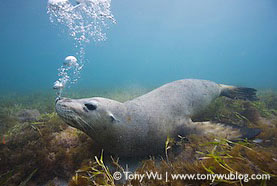 Last time I visited, with a few pointers from Captain Rick, I learned that the sea lions often greet one another by assuming a head-down position, often with posterior pointing toward the surface, and blowing a few bubbles. I mimicked this greeting to great effect previously, and did so again.
Last time I visited, with a few pointers from Captain Rick, I learned that the sea lions often greet one another by assuming a head-down position, often with posterior pointing toward the surface, and blowing a few bubbles. I mimicked this greeting to great effect previously, and did so again.
I suppose that knowing how to say "Hi" in any language helps. My greetings were immediately acknowledged, and we progressed rapidly to more advanced forms of communication, like back-scratching in the sea grass and lying on the bottom to contemplate life. Many of the people on the trip with me had also visited last year, and all were excellent swimmers, so it wasn't long before everyone was "conversing" with the sea lions.
The net effect of "fitting in" so quickly is that the sea lions seemed to settle into doing whatever they would've been doing anyway...which is absolutely perfect for observing their behaviour.
Of course, mostly what they were doing was swimming, so the primary challenge was to keep up with them. The water wasn't deep, but it's amazing how tiring it can be to swim for three to four hours straight...first left, then right, then left again, then in circles, then right again, then left, then in more circles...all the while diving down to play and coming up gasping for breath, followed immediately by diving down again, and so forth.
In between the constant activity were some extraordinary moments and experiences.
For example, there were a few occasions when I witnessed sea lions tossing around sea urchin skeletons, reminiscent of the manner in which puppies play with balls. They picked them up with their noses/ mouths and tossed them in the water column, sometimes to another sea lion, sometimes to no one in particular.
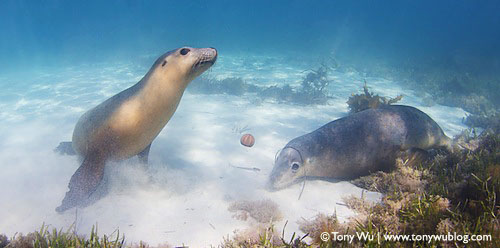 Having come across and participated in this type of play previously with dolphins using pieces of coral, cloth and other objects, I tried to engage the sea lions by picking up the makeshift toys and tossing them around. Whereas dolphins often react with apparent glee and try to snag the object in question, the sea lions did not.
Having come across and participated in this type of play previously with dolphins using pieces of coral, cloth and other objects, I tried to engage the sea lions by picking up the makeshift toys and tossing them around. Whereas dolphins often react with apparent glee and try to snag the object in question, the sea lions did not.
It's quite possible that I was doing something incorrectly, or perhaps that the sea lions just weren't interested in playing catch with me at the time. Hopefully if I'm able to visit again, I'll have more opportunities to see if the sea lions will humour me, or again demonstrate a cool indifference to my ball-tossing overtures.
Striking Similarities
As a brief aside, anyone who has a golden or labrador retriever will immediately pick up on the striking similarities between sea lions and these canine companions of ours. If you don't have a dog or haven't spent much time around them, perhaps the resemblance isn't quite as obvious, but it's not difficult to grasp.
Describing the similarities in words probably wouldn't have as much effect as showing a few examples, using some photos of Pasta for illustration purposes:





More Behaviour Stuff
Besides the urchin-tossing game, there was constant play-fighting going on, particularly among the young adults. As a reminder, all the sea lions at Carnac Island are male (this is unique as far as anyone knows).
 And just like other young male mammals, both on land and in the water, the juvenile males spent a lot of time wrestling one another, chasing each other, knocking each other about, etc.
And just like other young male mammals, both on land and in the water, the juvenile males spent a lot of time wrestling one another, chasing each other, knocking each other about, etc.
The seemingly logical explanation is that the young males were jockeying for relative pecking order, so that when it comes time to go impress young girl sea lions, the boys will know who's stronger than whom. (Gee, humans are much more civilised. We never do that.)
On occasion, the sea lions engaged in their testosterone-fueled debates right next to me, locking jaws (with impressive canine teeth) and rolling around in circles, followed by breaks, during which they swam nice-and-friendly-like next to one another, played with swimmers in the water, or just chilled out.
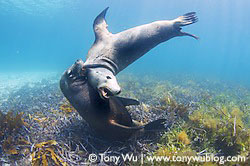 Usually, there were only two sea lions rough-housing at any given time and place, but in some instances we saw three, four or even more pumped-up pinnipeds pinning one another down. Quite a sight to behold.
Usually, there were only two sea lions rough-housing at any given time and place, but in some instances we saw three, four or even more pumped-up pinnipeds pinning one another down. Quite a sight to behold.
Newton's First Law
Way back when, in physics class, I studied a set of laws developed by Sir Isaac Newton to describe motion. The first of these laws states:
An object at rest tends to stay at rest and an object in motion tends to stay in motion with the same speed and in the same direction unless acted upon by an unbalanced force.
Though Newton articulated this universal principle to describe the motion of physical objects, little did I realise back then how relevant Newton's first law would be to Australian sea lions.
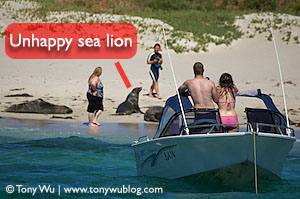 If you read my sea lion blog post from last year, one of the sections covers my perceived shortfallings of the Western Australian bureaucracy to protect the endangered Australian sea lions. (The authorities charged with oversight of the sea lions and Carnac Island fall under the Department of Environment and Conservation, though many people still refer to them by the acronym CALM, which stands for the Department of Conservation and Land Management. Without getting too carried away with sorting through the intricacies of the Western Australia bureaucracy, it's just easier to continue to refer to the authorities as CALM.)
If you read my sea lion blog post from last year, one of the sections covers my perceived shortfallings of the Western Australian bureaucracy to protect the endangered Australian sea lions. (The authorities charged with oversight of the sea lions and Carnac Island fall under the Department of Environment and Conservation, though many people still refer to them by the acronym CALM, which stands for the Department of Conservation and Land Management. Without getting too carried away with sorting through the intricacies of the Western Australia bureaucracy, it's just easier to continue to refer to the authorities as CALM.)
To put it simply...not much has changed.
- Local boaters still ignore the sanctuary signs. (All posted in English, which I presume everyone can read.)
- Local boaters are still de facto permitted to go up on land and do whatever they please, while tourists are forbidden to set foot or flipper on land. In fact, CALM made it a point to ring our boat and remind us that we're prohibited from going on the beach, even as hordes of people were clambering onto the beach right in front of our eyes. (Seems fair and logical, doesn't it?)
- The sea lions still mostly hang out at the non-sanctuary end of the beach, and CALM hasn't seen fit to redesignate the non-sanctuary end as the sanctuary end and vice versa. As I pointed out last year, this has the perverse effect of cramming people and sea lions into the same small portion of the beach, while the designated sanctuary section remains relatively empty. (Proof that fact is often stranger than fiction.)
- On the one occasion when the patrol boat came by, just like I witnessed last year, one of the CALM representatives went ashore, spoke with a few people, then left. Everyone behaved well while he was around, then promptly returned to doing whatever they were doing before he showed up, including shouting at the sea lions, waving boogie boards at them, sending little kids to pose by big bulls with big teeth, and so forth. (This would be comical, if not so tragic.)
-
 To reinforce their authority, CALM paid a visit to our boat and warned us to pull in our dive flag, which was floating about 2.5 metres behind the boat. Apparently, the fact that inebriated boaters were zipping with wreckless abandon at high speed through the water while ignoring swimmers wasn't a concern. Getting the dive flag out of the water though, was top priority, so much so that we were warned three times. (Huh? Seriously...huh?)
To reinforce their authority, CALM paid a visit to our boat and warned us to pull in our dive flag, which was floating about 2.5 metres behind the boat. Apparently, the fact that inebriated boaters were zipping with wreckless abandon at high speed through the water while ignoring swimmers wasn't a concern. Getting the dive flag out of the water though, was top priority, so much so that we were warned three times. (Huh? Seriously...huh?)
- And to really hammer home their iron-grip control of the situation, CALM warned us not to splash while swimming, as that would constitute harassment of the sea lions, while people standing on the beach kicking sand at the sea lions was perfectly ok though. (Sigh. Kafka would have a field day with this)
I would, however, be remiss in saying that absolutely nothing has changed since last year. Carnac Island was a nesting area for fairy terns...fidgety, rather shy birds that don't do well with too much ambient noise and racket. The number of fairy terns visiting the island had already dropped last year, and CALM knew about it.
This year, there were no fairy tern nests. None. They're all gone. So there's a change.
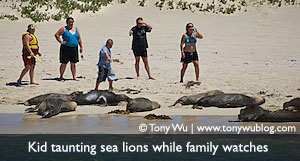 I suppose it would make sense to infer a relationship between the disappearance of the fairy terns and the growing number of people walking around on the island, climbing the dunes, blasting loud music, and wreaking general havoc on the landscape...but nah, that would make too much sense. It must have been our dangerous dive flag or the splashing from our fins that scared them away.
I suppose it would make sense to infer a relationship between the disappearance of the fairy terns and the growing number of people walking around on the island, climbing the dunes, blasting loud music, and wreaking general havoc on the landscape...but nah, that would make too much sense. It must have been our dangerous dive flag or the splashing from our fins that scared them away.
While Down Under, I learned that representatives of CALM had read my previous blog post and were unhappy with it. They were, as I gather, intending to write me to address the issues I raised. As much as I would have valued (and still would value) direct feedback from CALM, I never heard a peep.
I suppose this is where Newton's first law comes into play. To paraphrase:
CALM representatives doing nothing tend to continue to do nothing and CALM representatives doing unproductive things tend to continue doing such things with the same speed and in the same direction until forced to do the right thing by an outside force.
Who would've guessed Newton had such foresight?
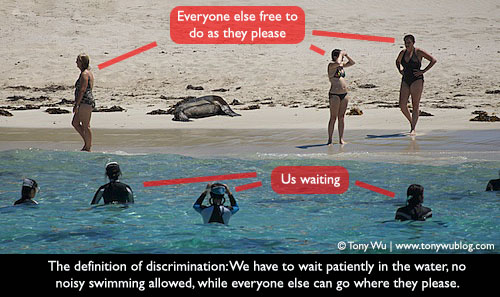 As I stated last year, I'm sure that the CALM people are overworked, underpaid, under-appreciated and stressed out. And to be fair, I'm quite certain that most of the people in CALM on an individual basis are probably really pleasant and reasonable. It's just that as the organisation charged with managing Carnac Island...how can I put this?...CALM really needs to get its act together. I have nothing against them, and I really hope that they can see their way to taking a few sensible steps along the lines of:
As I stated last year, I'm sure that the CALM people are overworked, underpaid, under-appreciated and stressed out. And to be fair, I'm quite certain that most of the people in CALM on an individual basis are probably really pleasant and reasonable. It's just that as the organisation charged with managing Carnac Island...how can I put this?...CALM really needs to get its act together. I have nothing against them, and I really hope that they can see their way to taking a few sensible steps along the lines of:
- Switching the sanctuary and non-sanctuary designations so that the sea lions have more of an opportunity to be left alone.
- Even better would be stopping everyone from going ashore. As it stands, CALM bans tourists only, while effectively allowing everyone else to do as they please. Given that most visitors to the island are local boaters, there's no sense whatsoever in current policy, at least insofar as the welfare of the island's wildlife is concerned. The policy makes complete sense if the first priority is to avoid offending local boaters while not really giving a hoot about the island, the sea lions, the fairy terns or anyone who's not a resident of Western Australia.
- Using your webcam to enforce the regulations and levy fines for egregious things like climbing the dunes, taunting sea lions with boogie boards, etc. I know the webcam works, since CALM was kind enough to call upon our arrival at the island and tell us not to go on the beach.
- Undertaking an education program to inform the public about why the sea lions, fairy terns and other inhabitants of Carnac Island need breathing room. Members of the local and international press would no doubt be more than happy to help, and most reasonable people, once aware of the issues, would probably be happy to comply with restrictions.
Sensible steps like these shouldn't be terribly difficult, right? And they would go a long way to keeping Carnac Island in tip-top shape, for people and animals alike.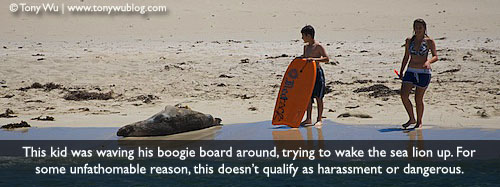
If CALM was unhappy with what I wrote last year, no doubt the reaction will be the same if they read what I've written this year. So CALM: If I've mis-stated anything here, please do let me know. I'm more than happy to set the record straight if I've made a mistake. Assuming that my observations are correct, please take the constructive criticism in the manner in which it is intended...constructively.
Serendipity
Once in a while, stars line up, ducks get in a row, tea leaves look good, fortune smiles...and you get a lucky break. In the context of observing and photographing marine life, of course, you have to be paying attention to see it coming.
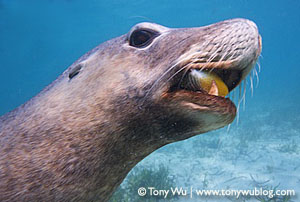 On my final day out on the water (actually, it was an extra, un-planned day), there was one young sea lion in particular who seemed eager to have company as he swam around the shallow bay.
On my final day out on the water (actually, it was an extra, un-planned day), there was one young sea lion in particular who seemed eager to have company as he swam around the shallow bay.
As flakey as this sounds, it was as if the juvenile pinniped signalled to me that he was going to be particularly mischievous, and wanted to show off. He just gave off a certain vibe.
I know, if someone else said that to me, I'd take two steps back and make a beeline for the nearest escape route. But...and this is an important but...I've had similar sixth-sense feelings before, and quite often, listening to my gut has paid off (of course, sometimes it results in nothing more than a stupid look on my face).
Long story made short, my sea lion companion led me over to a patch of sea grass, where instead of lying down and scratching his back, he poked around for a bit, peeked knowingly "over his shoulder" a couple of times at me, then suddenly presented me with a pretty little boxfish. The smug look on his face was unmistakable.
 The fish, obviously quite displeased with the turn of events, decided to depart in haste, only to be pursued and re-snagged by my agile friend, who once again held up the little fish for inspection, who once again politely but insistently excused itself, only to be snared yet again...
The fish, obviously quite displeased with the turn of events, decided to depart in haste, only to be pursued and re-snagged by my agile friend, who once again held up the little fish for inspection, who once again politely but insistently excused itself, only to be snared yet again...
This "I got you", "No you don't" entertainment (for the sea lion, not so much for the fish) lasted for perhaps a minute or so, with the action running fast-and-furious, until the sea lion bored of the little boxfish and let it go, whereupon the frazzled fish made its way back to the sea grass in a bewildered daze, unhappy but unhurt.
The sea lion was simply flaunting his agility, and giving me a glimpse of the skill he no doubt brings to bear when chasing down a meal.
Wrapping Up
A lot, lot more happened, but it's just not possible or realistic to try to convey everything. With two trips to see the sea lions under my belt now, I feel like I'm beginning to understand their behaviour. Or rather, I'm beginning to understand the behaviour of the small group of male sea lions that frequent Carnac Island. Whether the behaviour of this group carries over to other colonies or not...I have no clue. If I'm fortunate enough to have a chance to visit other colonies at some point, perhaps I'll be able to compare.
I'll wrap this up with one other highly entertaining behaviour that I observed. As I mentioned earlier, the sea lions seemed to associate our boat with play. On the second day of the trip in particular, a bunch of sea lions spent hours swimming around the boat, often lying on the sand next to the boat, or even directly under it.
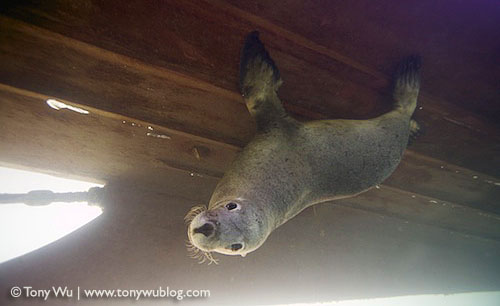 One especially fun-loving sea lion swam up next to me, then went under the boat, turned upside down, and "stood" on the hull of the boat...upside down. I laughed so hard I dumped all the air in my lungs and nearly didn't get a photo, but the sea lion was kind enough to wait for me to cough up the mouthful of seawater I had swallowed, get another breath and compose this portrait.
One especially fun-loving sea lion swam up next to me, then went under the boat, turned upside down, and "stood" on the hull of the boat...upside down. I laughed so hard I dumped all the air in my lungs and nearly didn't get a photo, but the sea lion was kind enough to wait for me to cough up the mouthful of seawater I had swallowed, get another breath and compose this portrait.
More photos on Flickr.